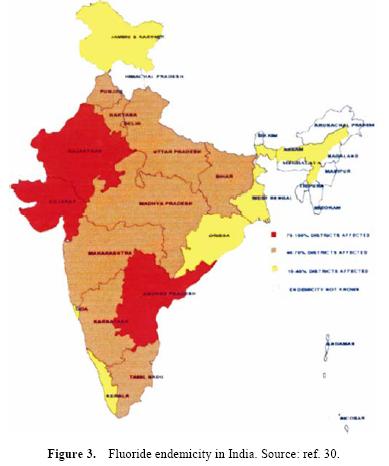 The article informs that access to safe drinking water remains an urgent necessity, as 30% of urban and 90% of rural households still depend completely on untreated surface or groundwater.
The article informs that access to safe drinking water remains an urgent necessity, as 30% of urban and 90% of rural households still depend completely on untreated surface or groundwater.
While access to drinking water in India has increased over the past decade, the tremendous adverse impact of unsafe water on health continues. It is estimated that about 21% of communicable diseases in India are water related.
Although some degree of intervention in terms of chlorination and monitoring of water quality exists in major cities and towns, rural India, which constitutes the bulk (70%) of the population, is usually deprived of such interventions. The population in rural India is mainly dependent on the groundwater as a source of drinking water. As a quality concern the groundwater is often found to be contaminated with fluoride, arsenic, iron and salts. In recent years, fluorosis has emerged as major public health issue in rural India.The paper informs that monitoring groundwater quality remains a prime concern and a major challenge in rural India considering the geographical spread of Indian villages and the fact that many of the remote villages are not accessible to regular monitoring by central agencies due to transportation and communication problems. Hence it is the rural population that suffers the most from problems related to fluoride, arsenic as well as microbial contamination.
No system has yet been devised or put in place that is able to consolidate the water quality data generated by district laboratories to convey meaningful village/source level information on water quality at the national level.
Although the burden of diarrhoeal disease resulting from inadequate water quality, sanitation practice and hygiene remains high, there is little understanding of the integration of these environmental control strategies. At present, the central and state agencies promote chlorine bleach (bleaching powder) for disinfection of community water sources, including wells on an ad-hoc basis and therefore, no guidelines have been adopted for regulating dosage and contact time of chlorination.
The paper suggests that :
- Under the present circumstances, one of the ideal ways to obtain safe water for the community is to promote point of use disinfection along with hygienic water-storage practices. This may prove to be a viable option and would cost less than 5 dollars a year per household.
- Redesigning of data management programme at village, district and at national level, upgradation of district-level laboratories and addressing technical, legal and institutional components should become the first steps in achieving effective water-quality management and providing better health to millions of people living in rural India.
- Community participation in operation and maintenance of the water treatment structure is vital in addressing the gaps in the sector. Research and review of national drinking standards taking into consideration the local condition, especially with regard to critical parameters like fluoride and arsenic is vital for preserving public health.
- Citizen action groups and civil societies should be increasingly engaged in making the government accountable in enforcing regulation with regard to industrial effluent and sewage treatment plant for preventing surface and groundwater contamination.
- Outsourcing water quality data management and sample collection and monitoring could be an alternative mechanism that can be explored, which would ease the burden on the state and bring better efficiency and sustainability. More scientific debate on privatisation of water quality management in India needs to be considered.
Download the paper here













